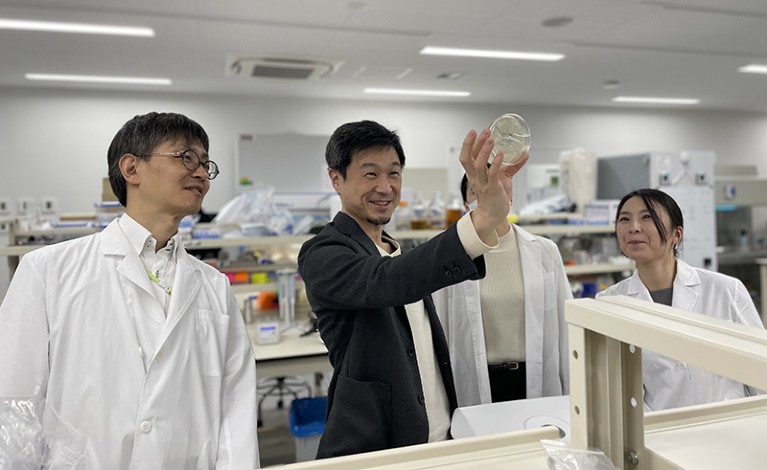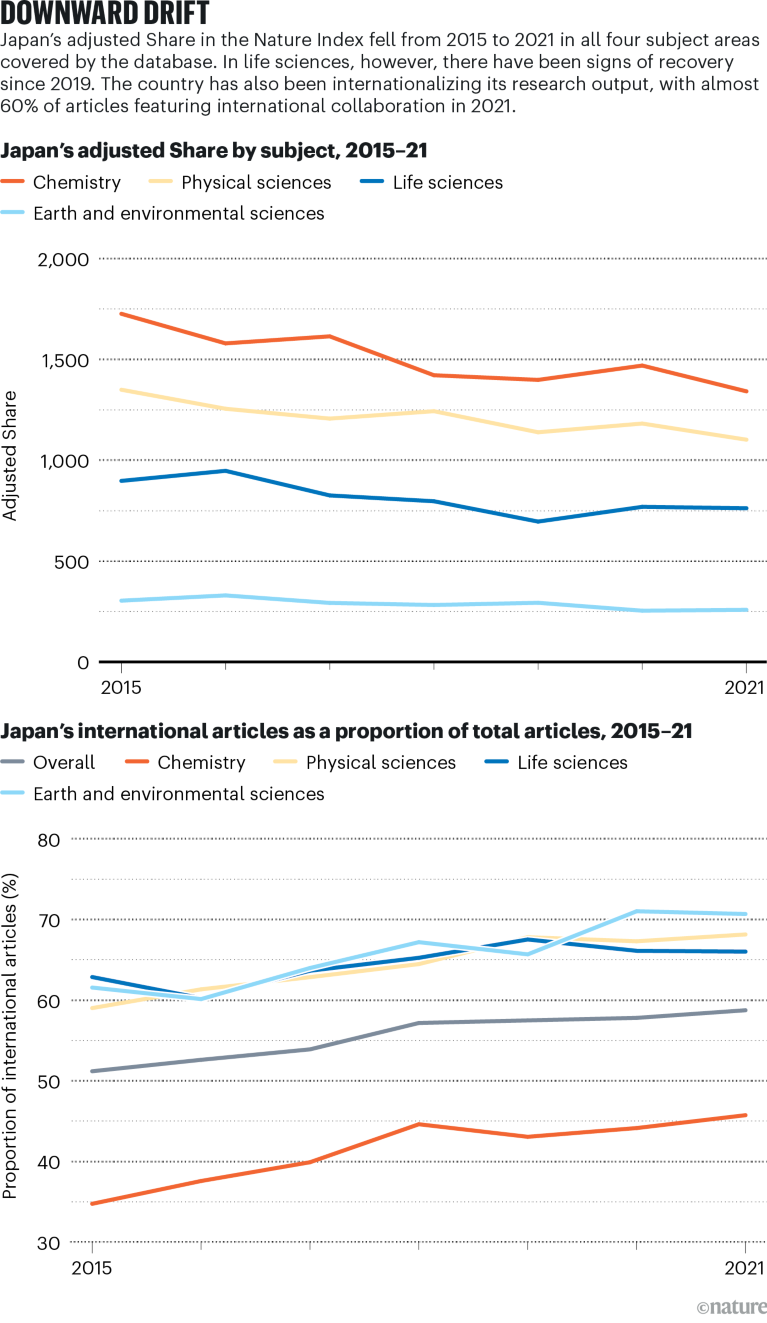
A culture tank intended for the mass production of a COVID-19 vaccine developed by Japanese firm Shionogi.Credit: The Yomiuri Shimbun via AP Images
After five years studying genome editing at Harvard Medical School in Boston, Massachusetts, Keiji Nishida returned to Japan in 2013, and soon felt worried. How would his home country compete in this new field? It was a time when the gene-editing technique, CRISPR–Cas9, was making headlines for its groundbreaking potential to cheaply splice and rearrange genes, raising hopes for cures for many diseases.
“I was concerned that Japan was not catching up with the revolution that genome-editing technology was about to bring,” says Nishida, now a synthetic biologist at Kobe University’s BioProduction Engineering Lab.
Data on Japan’s output in the Nature Index, which tracks research publications in 82 high-quality natural-science journals, from 2015 onwards suggest Nishida’s apprehension about Japan falling behind in his field was not an isolated problem; the nation’ s adjusted Share in the index fell by 19.1% between 2015 and 2021.
Kobe University — which is ranked 24th in Japan by Share for 2022 — has also seen a decline in its Nature Index output in the past few years. Its adjusted Share fell by 37.9% from 2017 to 2022 (the 2022 data are approximated by a 12-month window from October 2021 to September 2022).
There are emerging signs, however, that Japanese science could be turning a corner. Japan’s decline in output has not been continual since 2019, according to Nature Index data. Its adjusted Share rose by 4.1% from 2019 to 2020, although it still fell by 5.2% the following year. Life sciences is one area where Japanese research seems to be performing better; its adjusted Share in the field fell by 7.7% from 2017 to 2021, a drop in Share that was lower than other subjects covered by the Nature Index. Kobe University’s Share in life sciences, meanwhile, has been rising consistently since 2019.
These potential green shoots in Japan’s research performance could be down to work that life-sciences researchers such as Nishida have been pursuing.
After he returned to Japan, Nishida set to work on devising a way in which the country could play an important role in the emerging industry of gene editing. Nishida hoped to address some of the limitations of CRISPR–Cas9, which, as he describes it, didn’t always slice genes at the precise target location. He was lucky enough to get both funding and freedom from another chemist, Akihiko Kondo, his mentor at Kobe University.
Replicating successes
In 2016, after three years of research, Nishida and his colleagues published a paper1 in which they described his new base-editing technique, which edits genomes by altering the composition of DNA in situ instead of cutting and pasting new genes as in CRISPR–Cas9.
“Issues with conventional CRISPR genome editing have been associated with its DNA cleavage process, which causes toxicity to cells or may result in unpredictable editing outcomes,” says Nishida.
Nishida raised about $3.7 million from US venture-capital funds and established Bio Palette in 2017 to commercialize his research. The biotech firm, also based in Kobe, is developing Target-AID, a version of the editing technique for use in therapies that target the microbiome. Researchers at Bio Palette believe this could help treat inflammatory bowel disease, cancer and neurological disorders. The company has raised about $15 million to date from investors.

(From left) Ryo Ueta, Keiji Nishida, Kaho Kuramoto and Yumiko Nambu investigate genome-edited microbial colonies at Bio Palette in Kobe.Credit: Kiyokazu Iwata
Bio Palette is not the only example of a life-sciences company spun out of Kobe University research in the past few years. In 2020, partnering with Japanese companies including Rohto Pharmaceutical and Taiyo Oil, Kondo led a Kobe research group to set up Bacchus Bio Innovation to serve as a bio-foundry. The group envisioned a factory that can pump out useful genetically modified organisms, such as yeast, that can be used as raw materials for pharmaceuticals or chemical products.
For Japan to replicate these successes across other institutions and fields, however, and so sustain a reversal in its Nature Index performance, will require a concerted effort from policymakers.
“There should be a holistic approach to the revival of Japan’s research,” says Yuko Aihara, director at the planning division of the National Institute of Science and Technology Policy in Tokyo. University management and research capabilities need to be improved, doctoral students need to be supported, and research time needs to be secured and ringfenced from other duties such as teaching, Aihara says.
A costly turnaround
Earlier this year, the Japanese government decided to invest in a select group of universities with a ¥10-trillion (US$75-billion) endowment fund that would allow them to produce world-class research and compete globally. That’s good news for the elite of Japanese university research but it has sidelined many institutions and researchers who aren’t perceived to be science stars.
“We specialize in young researchers, especially those who have returned from abroad and need funding for start-ups,” says Yukihide Hayashi, head of the Life Science Foundation of Japan, based in Tokyo, which aims to improve overall public health by supporting 12 younger researchers each year with a budget of ¥1 million each. “We are trying to nurture those that will become excellent researchers in the future, with a small budget.” This is a different approach from the standard funding models favoured by Japan’s large grant-giving organizations, which finance more conventional research proposals, says Hayashi.
Recently established agencies are also trying to make a difference. Hayashi attributes the small improvement seen in Japan’s life-sciences research to the creation of the Japan Agency for Medical Research and Development (AMED), a national funding body overseen by the government. Founded in 2015 under former prime minister Shinzo Abe, the agency aims to rapidly progress medical research findings into treatments.
AMED supported research by a team led by Hokkaido University’s Satoshi Ichikawa, for example, that designed and synthesized an antibiotic2 to target bacteria that are resistant to multiple drugs. In another effort, the agency helped with clinical trials to verify a coronavirus vaccine developed by Osaka-based pharmaceutical company Shionogi. The drug maker applied for approval of the vaccine, the first homegrown COVID-19 jab in Japan, with the health ministry in November 2022. Shionogi is unsure of exactly how long it might take to receive an approval, but such processes usually take about 12 months.

Source: Nature Index
Another bright spot in Nature Index data is international collaborations. Since at least 2015, Japan has continued to increase its percentage of international articles.
One example of this, again in the life sciences, is the announcement in November that an Alzheimer’s drug called lecanemab that was developed by pharmaceutical company Eisai, based in Tokyo, and biotechnology firm Biogen, based in Cambridge, Massachusetts, provided moderate cognitive benefit to patients. In an 18-month study3 of nearly 1,800 participants, those who received the drug saw cognitive decline slow by 27% compared with a placebo. Sold as Leqembi, lecanemab targets a protein called amyloid-β that forms between neurons in the brain. In January 2023, the US Food and Drug Administration approved the drug via an accelerated process for serious medical conditions, the second Alzheimer’s medicine of its type to gain such approval in the past two years.
Regulators are still monitoring data about lecanemab’s safety after three deaths among patients in the study raised concerns about potentially dangerous side effects. Nonetheless, it’s the first drug of its kind to stem mental decline in a robust clinical trial, and has sparked great expectations.
Human resources
Japan still faces other persistent issues, however, that could be stymieing its progress. One is the shrinking number of researchers pursuing doctoral degrees, a problem linked to the nation’s dwindling population, which peaked in 2008 and has continued to decline ever since.
“In Japan, fewer and fewer students are interested in pursuing a PhD and a career as a researcher,” says Nishida. “I’m trying to expand the careers of scientific researchers by developing an ecosystem where academia, industry and entrepreneurs interact and exchange knowledge and talent in a more dynamic way.” Nishida’s graduate students participate in special programmes, for example, in which they learn about business and finance strategies. They’re also trained to create business plans and proposals based on their lab research.
Like Nishida, biophysicist Kazuhiro Maeshima benefited from years of research overseas before he joined the Genome Dynamics Laboratory at the National Institute of Genetics (NIG), based in Shizuoka.
“Of course, universities in Japan have academic freedom, but professors are too busy with educational duties, especially for undergraduates, to perform their research,” says Maeshima. “Our NIG is a small genetics institute, but we have lots of academic freedom. Essentially, we can do what we want. This may be pretty rare in Japan, but we believe it’s a critical factor in performing exciting research.”
His research4 has since challenged the conventional wisdom about the structural organization of chromatin, the mixture of DNA and proteins that form chromosomes in cells. International collaborations remain important: Maeshima says he’s keen on working with colleagues in Australia because of the country’s relatively small, high-quality research community and the fact that it’s roughly in the same time zone as Japan.
Looking to the future, he places his hopes for Japanese science squarely on young people. “The main challenges to Japanese science are decreasing budgets and the number of students who enter PhD courses,” says Maeshima. “However, although science in Japan may face a more and more difficult time, I am pretty optimistic because there are always some young, talented and motivated people who can conduct exciting research.”


 Is Japan’s research decline turning a corner?
Is Japan’s research decline turning a corner?
 Japan’s leading international partnerships
Japan’s leading international partnerships
 Freeing up Japan’s PhD potential
Freeing up Japan’s PhD potential
 Japan’s rising research stars: Mariko Kimura
Japan’s rising research stars: Mariko Kimura
 Japan’s rising research stars: Yuuki Wada
Japan’s rising research stars: Yuuki Wada
 Japan’s rising research stars: Tatsuya Kubota
Japan’s rising research stars: Tatsuya Kubota
 Japan’s rising research stars: Yasuka Toda
Japan’s rising research stars: Yasuka Toda
 Japan’s rising research stars: Ken-ichi Otake
Japan’s rising research stars: Ken-ichi Otake
 Will Japan’s new ¥10-trillion university fund lift research performance?
Will Japan’s new ¥10-trillion university fund lift research performance?
 Shoring up Japan’s research performance
Shoring up Japan’s research performance
 How Japan’s disciplinary strengths are shifting focus
How Japan’s disciplinary strengths are shifting focus
 Japanese robotics lags as AI captures global attention
Japanese robotics lags as AI captures global attention








